-
4 Benefits of Aluco Steel Replica Bi-Folding Doors
Vestibulum volutpat vitae nisi vel eleifend. Etiam dictum elit eget malesuada scelerisque. Duis nibh ante, faucibus eget mi eu, scelerisque rutrum ex. Duis tristique consequat...
-
Choosing the right glass balustrade for your home
Vestibulum volutpat vitae nisi vel eleifend. Etiam dictum elit eget malesuada scelerisque. Duis nibh ante, faucibus eget mi eu, scelerisque rutrum ex. Duis tristique consequat...



